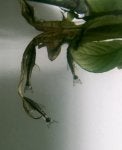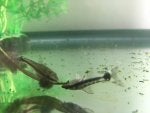These guys can be really hard to keep alive through the acclimation period. I am by no means an expert on otos. I had seven die on me last year. But I am trying again now; and would like to pass on some observations and possible tips.
1. Get healthy otos to begin with. Pay really careful attention to how they behave in the fish store! Many of us have heard that so many otos are shipped in terrible condition and are barely hanging on in the LFS before making their way to you, where they promptly or eventually die. I went to a fairly reputable LFS to get otos in two batches last year -- they all eventually died. A couple died within a week; the rest died over the next 3-5 months. Now it *definitely* could have been my fault that they died! But I have also been realizing after watching a million YouTube videos that my otos NEVER acted healthy from the beginning, and that I don't think I actually knew how healthy otos behave, which made me very uninformed as a consumer when I went to the LFS. I have since gone to the home of a top-notch online seller and fish expert whose otos are in perfect condition. I am now in Day 2; all 8 have survived 48 hours, including the 8-hour journey in the car back to my house. I did the " plop and drop" acclimation method - it worked fine. Fingers crossed!
My observation is that these healthy otos graze in a relaxed, graceful and continual motion throughout much of the day. They do rest for stretches of time, but they are not usually either hyperactive, darting like crazy, or super-dormant, for too long. They are not merely nocturnal; healthy otos will swim around in open water during the daylight. They have fairly full stomachs, with their white bellies protruding a little. And their color is fairly dark, not red or translucent around the head or sides.
2. Get otos in quantity. I think I made the mistake of never having more than 4 otos at one time. And one or two of them were usually ill. So far, my 8 otos are not shoaling, but I do notice them fairly close together a lot of time. I think this helps them, especially in the beginning when they are adjusting to new surroundings.
3. Have a mature quarantine tank with algae growth. I've kept a quarantine tank going for several months continuously - the last 2 months without any fish (just add fish flakes to keep the bacteria cycle going). There was a lot of algae growth - 95% of which was consumed by the 8 otos within 2 days. I'm happy they had good food to begin with. They also devoured a cucumber slice. Hooray.
4. WATCH for issues in the first several days. Here's my story: so this morning of Day 2, I noticed that 2, possibly 3 of the otos were breathing really fast and doing that sickly oto thing (not moving much, hiding). Must be some kind of stress from water parameter issue - I can't pick up anything noticeable in my water testing, but I have been down this road before with otos and it has never ended well. Some usually die within a day or two of the fast breathing stage. Others hang on for weeks or months. But they have all died. So I was really anxious this morning. Here's what I did, and after five or six hours, it has apparently WORKED (the fast breathing stopped and the otos are acting relaxed and non-shy again).
(a) partial water change (about 20%).
(b) inserted another strip of Polyfilter in tank (if you haven't heard of Polyfilter, look it up - I am using it for the first time) to adsorb/absorb bad stuff.
(c) repositioned my airtube bubbler to create a much stronger oxygen current in the tank. The water surface is actually wobbly now.
(d) clipped some algae-grown leaves from my non-quarantine tank and threw them in the quarantine tank w the otos (theory: the microorganisms and bacteria and algae on the leaves are familiar and comforting and nutritional to the otos and good for the water quality).
I'm not sure which of the above was most responsible for the return to normal behavior, but I am going to repeat this in the future if a problem arises.
Stay tuned. Here are a few photos of the little guys now.
1. Get healthy otos to begin with. Pay really careful attention to how they behave in the fish store! Many of us have heard that so many otos are shipped in terrible condition and are barely hanging on in the LFS before making their way to you, where they promptly or eventually die. I went to a fairly reputable LFS to get otos in two batches last year -- they all eventually died. A couple died within a week; the rest died over the next 3-5 months. Now it *definitely* could have been my fault that they died! But I have also been realizing after watching a million YouTube videos that my otos NEVER acted healthy from the beginning, and that I don't think I actually knew how healthy otos behave, which made me very uninformed as a consumer when I went to the LFS. I have since gone to the home of a top-notch online seller and fish expert whose otos are in perfect condition. I am now in Day 2; all 8 have survived 48 hours, including the 8-hour journey in the car back to my house. I did the " plop and drop" acclimation method - it worked fine. Fingers crossed!
My observation is that these healthy otos graze in a relaxed, graceful and continual motion throughout much of the day. They do rest for stretches of time, but they are not usually either hyperactive, darting like crazy, or super-dormant, for too long. They are not merely nocturnal; healthy otos will swim around in open water during the daylight. They have fairly full stomachs, with their white bellies protruding a little. And their color is fairly dark, not red or translucent around the head or sides.
2. Get otos in quantity. I think I made the mistake of never having more than 4 otos at one time. And one or two of them were usually ill. So far, my 8 otos are not shoaling, but I do notice them fairly close together a lot of time. I think this helps them, especially in the beginning when they are adjusting to new surroundings.
3. Have a mature quarantine tank with algae growth. I've kept a quarantine tank going for several months continuously - the last 2 months without any fish (just add fish flakes to keep the bacteria cycle going). There was a lot of algae growth - 95% of which was consumed by the 8 otos within 2 days. I'm happy they had good food to begin with. They also devoured a cucumber slice. Hooray.
4. WATCH for issues in the first several days. Here's my story: so this morning of Day 2, I noticed that 2, possibly 3 of the otos were breathing really fast and doing that sickly oto thing (not moving much, hiding). Must be some kind of stress from water parameter issue - I can't pick up anything noticeable in my water testing, but I have been down this road before with otos and it has never ended well. Some usually die within a day or two of the fast breathing stage. Others hang on for weeks or months. But they have all died. So I was really anxious this morning. Here's what I did, and after five or six hours, it has apparently WORKED (the fast breathing stopped and the otos are acting relaxed and non-shy again).
(a) partial water change (about 20%).
(b) inserted another strip of Polyfilter in tank (if you haven't heard of Polyfilter, look it up - I am using it for the first time) to adsorb/absorb bad stuff.
(c) repositioned my airtube bubbler to create a much stronger oxygen current in the tank. The water surface is actually wobbly now.
(d) clipped some algae-grown leaves from my non-quarantine tank and threw them in the quarantine tank w the otos (theory: the microorganisms and bacteria and algae on the leaves are familiar and comforting and nutritional to the otos and good for the water quality).
I'm not sure which of the above was most responsible for the return to normal behavior, but I am going to repeat this in the future if a problem arises.
Stay tuned. Here are a few photos of the little guys now.






